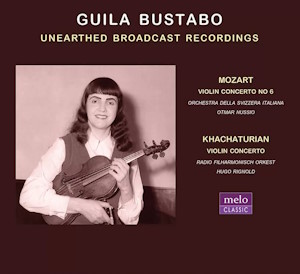
Guila Bustabo (violin)
Unearthed Broadcast Recordings
Wolfgang Amadeus Mozart (1756-1791)
Violin Concerto No 6 in D Major, KV 218
Aram Khachaturian (1903-1978)
Violin Concerto in D Minor
Orchestra della Svizzera Italiana/Otmar Nussio
Radio Filharmonisch Orkest/Hugo Rignold (Khachaturian)
rec. live, 4 June 1965, RSI, Teatro Kursaal, Lugano; 4 May 1966, AVRO Studio, Hilversum (Khachaturian)
Meloclassic MC2058 [69]
There’s a marvellously detailed biography accompanying this new release from Meloclassic by Dr. Christof Honecker, and it make a fascinating read. Guila Bustabo was born in Wiscontin in 1916. Her studies included periods with Louis Persinger, George Enescu and Jenö Hubay, and she later received the encouragement of Toscanini, Kreisler, Beecham and Ernest Schelling. I once read that she was “The Best Forgotten Violinist of All Time”. Maybe one reason for this is that the bulk of her concertizing took place before World War 11. Sadly, when War ended her career never fully took off again. Her main problem was that she was dominated by an over-protective mother, and in 1970 she suffered a breakdown; she was diagnosed with bipolar disorder. She devoted many of her remaining active years to teaching, where she held a post in Innsbruck from 1964 to 1970. For a time she played in the first violin section of the Alabama Symphony Orchestra. Thereafter she lived the life of a recluse, plagued by mental illness.
The so-called Violin Concerto No. 6 in E♭ major, K. 268, once thought to have been from the pen of Mozart, is now thought to have been written by Johann Friedrich Eck (1767–1838). Some maintain that Mozart had a hand in some of its composition but, at the end of the day, many scholars consider the attribution to be spurious. That said, it’s a lusciously lyrical work, brimming over with melodic invention. I got to know it years ago through Menuhin’s recording with the Bath Festival Orchestra. There’s also a magnificent performance of it by Jacques Thibaud from 1927. The outer movements of Bustabo’s reading are taken at a slower pace than the two performances I’ve just mentioned, nevertheless it’s a glowing account, and Otmar Nussio is a sensitive and supportive partner. Bustabo’s rich warm tone radiates throughout, especially in the central slow movement, where her phrasing is fervent, prayerful and tender. The Rondo finale features some clean, crisp and incisive spiccato passages.
The Khachaturian Concerto is an optimistic affair, and this 1966 broadcast recording from Hilversum is captured to good effect. The outer movements are suffused with exotic Armenian flavour and are punchy, rhythmically buoyant and brim over with energy and gusto. The slow movement is expressive and eloquently wrought. Hugo Rignold is with his soloist all the way. His deft handling of orchestral detail and musically informed support are admirable.
This is yet another welcome and wonderful addition to Meloclassic’s roster of, mainly off-the-radar, violinists. It constitutes a worthy addition to the meagre Bustabo discography. I’ve already referred to the booklet notes, and they are outstanding in every respect. These live studio recordings from the 1960s have been well-preserved and are in amazing shape. I might just add that I’ve had the pleasure of reviewing two other releases of the violinist’s recordings issued by the label (review ~ review).
Stephen Greenbank
Availability: Meloclassic


















